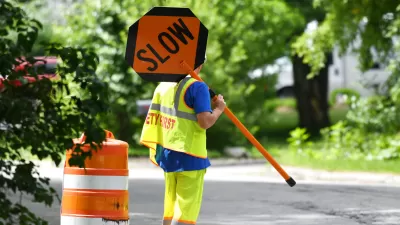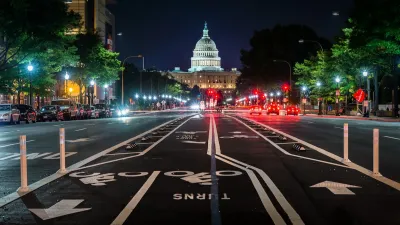Two safe streets advocates give their recommendations for how to effectively use the $1 billion in annual funding available through a federal grant program.

Writing in Streetsblog, Melissa Balmer and Leah Shahum outline some ideas for how cities can effectively put to use the annual $1 billion dedicated to Vision Zero projects through the Safe Streets and Roads for All (SS4A) grant program.
The authors outline the basics of the program: who can apply, due dates, and what kind of projects qualify. Encouragingly, they write, “This is a mercifully streamlined application process, so don’t be daunted! While a 20 percent match is required, there are creative ways to fulfill that requirement.”
Balmer and Shahum suggest ways that communities can use these grants. First and foremost, it’s important to develop a “strong and equitable” Vision Zero plan that “can help your community institutionalize Vision Zero, setting explicit timelines, deliverables, and accountability measures.”
Second, the authors write, “Think Big, Bold & System-Wide for Implementation Projects.” The federal funding can support infrastructure projects that put action plans into literal action, such as “widespread, high-impact, cost-effective design treatments” such as speed humps, improved crosswalks, and other traffic calming measures.
Thirdly, the authors highlight a number of projects that would qualify for supplemental planning grants, such as racial and health equity plans for roadway safety work, reforming traffic enforcement with a focus on safety without over-criminalization, and education on Safe System principles.
FULL STORY: OPINION: How To Use the Money Available for Safe Streets

Americans May Be Stuck — But Why?
Americans are moving a lot less than they once did, and that is a problem. While Yoni Applebaum, in his highly-publicized article Stuck, gets the reasons badly wrong, it's still important to ask: why are we moving so much less than before?

Using Old Oil and Gas Wells for Green Energy Storage
Penn State researchers have found that repurposing abandoned oil and gas wells for geothermal-assisted compressed-air energy storage can boost efficiency, reduce environmental risks, and support clean energy and job transitions.

Placekeeping: Setting a New Precedent for City Planners
How a preservation-based approach to redevelopment and urban design can prevent displacement and honor legacy communities.

San Francisco’s Muni Ridership Grew in 2024
The system saw its highest ridership since before the Covid-19 pandemic, but faces a severe budget shortage in the coming year.

Colorado Lawmakers Move to Protect BRT Funding
In the face of potential federal funding cuts, CDOT leaders reasserted their commitment to planned bus rapid transit projects.

Safe Streets Funding in Jeopardy
The Trump administration is specifically targeting bike infrastructure and other road safety projects in its funding cuts.
Urban Design for Planners 1: Software Tools
This six-course series explores essential urban design concepts using open source software and equips planners with the tools they need to participate fully in the urban design process.
Planning for Universal Design
Learn the tools for implementing Universal Design in planning regulations.
Heyer Gruel & Associates PA
City of Moreno Valley
Institute for Housing and Urban Development Studies (IHS)
City of Grandview
Harvard GSD Executive Education
Salt Lake City
NYU Wagner Graduate School of Public Service
City of Cambridge, Maryland





























